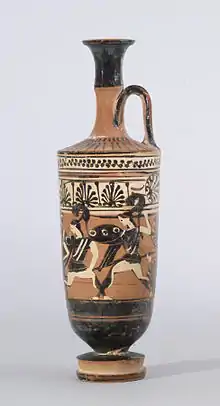Haimon Painter
The Haimon painter was a anonymous 5th-century BC Ancient Greek painter and draughtsman, so named by C.H.E. Haspels and John Beazley on account of a recurring subject in his black-figure vase painting—the Sphinx and its victim, the last of whom—according to a Greek myth—was Haimon. His name is unknown, but individual characteristics of style suggest the existence of a unique artistic personality. He specialized mostly in lekythoi and was closely related in manner to other contemporary Athenian vase-painters.[1][2]
| Wikimedia Commons has media related to Haimon Painter. |

The Haimon Painter. Three Amazons and Herakles.
Walters Art Museum.
References
- "The Haimon Painter (Biographical details)". Collection Database. The British Museum. Retrieved 9 October 2016.
- J., F. F. (1952). "Four Vases by the Haimon Painter". Record of the Art Museum, Princeton University. 11 (1): 5–9. doi:10.2307/3774275.
This article is issued from Wikipedia. The text is licensed under Creative Commons - Attribution - Sharealike. Additional terms may apply for the media files.